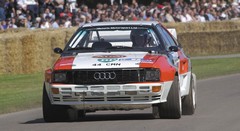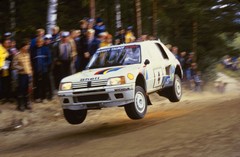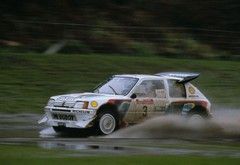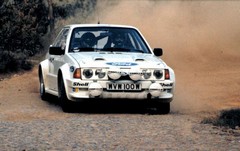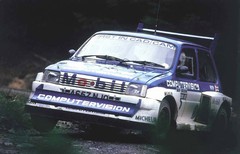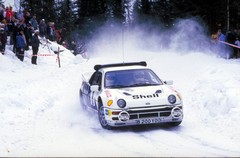Group Therapy
Group B's rally supercars were at their height 20 years ago but came to an unhappy end, as Andrew Noakes reports
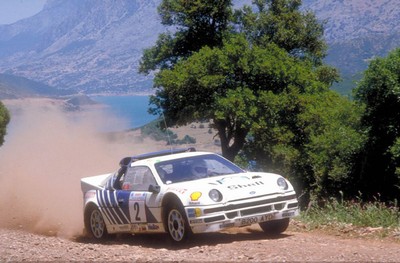
Stig Blomqvist pilots the Ford RS200 in 1986 -- Group B's last year
Group B produced the fastest and most exciting rally cars the sport has ever seen. Purpose-built supercars generating massive power, matched by peerless four-wheel drive traction, they accelerated at a rate that rivalled F1 cars and propelled rallying into an unparalleled era of power and performance.
For 1983 a wholesale revamp of motor sport regulations divided cars into groups based on production numbers. Group A, the race and rally category for production-based cars, called for a production run of 5,000 cars. Group B, which would be the formula used in World Championship rallying, required a run of just 200 cars – and of those, 20 cars could be further modified into an ‘Evolution’ specification.
Audi quattro hits the spot
Already Audi’s quattro was proving the value of four-wheel drive on loose-surface events and the quattro had won the World Championship in 1982, but the Germans didn’t have everything their own way. The quattros had been built for the old Group 2 regulations, and Lancia appeared in 1983 with a brand new car, the supercharged 037 Rally. Though only two-wheel drive, the 037 was purpose-built to take advantage of the freer Group B rules (notably giving the 037 a 100Kg weight advantage over the quattro) and it swept to the World Championship in 1983.
Audi was back in 1984 with the shorter, lighter and more powerful Sport quattro, but at the Tour de Corse Peugeot’s new 205 Turbo 16 arrived, Ari Vatanen astonishing everyone with the Peugeot’s speed (though it failed to finish). It looked very much like a wide-arched 205GTI, but the T16 was a very different car with a tubular spaceframe chassis and a 1.8-litre, 16-valve turbo engine developing well over 400bhp. It seemed inevitable that Peugeot would win everything in 1985 until team leader Vatanen rolled his 205T16 in Argentina and his seat mountings broke: Vatanen was lucky to survive, and was out of rallying for the rest of the year. But Peugeot’s second driver Timo Salonen stepped up, and went on to win the World Championship that year.
Lancia arrives
Peugeot would win again in 1986, this time with Juha Kankkunen at the wheel, but the competition was becoming ever tougher. Towards the end of 1985 Ford, Lancia and Austin Rover all introduced new four-wheel drive Group B cars which sought to break Peugeot’s stranglehold on the sport.
Lancia’s new machine was the Delta S4 which, like the Peugeot, boasted a tubular spaceframe for light weight, a sophisticated all-wheel drive transmission and a forced-induction engine. While the 037 had been supercharged, the Delta S4’s 1,759cc in-line four was both supercharged and turbocharged, the former providing good mid-range power and the latter taking over at the top of the rev-range. The car made its debut on the RAC Rally in November 1985, where the popular Henri Toivonen recorded its maiden win with his team mate Markku Alen second.
Austin Rover’s Group B contender also made its debut in that RAC Rally. Designed by Williams Grand Prix Engineering, the MG Metro 6R4 looked like a shopping-trolley Metro with massive arches and aerofoils front and rear, under which was a tube frame and a 24-valve V6 engine (based on a cut-down Rover V8) mounted at the rear. Tony Pond did most of the development driving and brought the 6R4 home to third place behind the Lancias in its debut rally.
Ford's RS200
Ford had been absent from the early years of Group B. It had begun by developing a rear-drive car, the Escort RS1700T, which Ari Vatanen and Pentti Airikkala tested in Portugal in 1982, one car fitted with a turbocharged 1.8-litre Cosworth BDT engine and another with a normally-aspirated 2.3 litre Hart 420R unit. But development dragged on and by the time the RS1700T was near completion early in March 1983, it was frankly old hat. Four-wheel drive was clearly the way forward, so the RS1700T was cancelled in favour of a purpose-built four-wheel drive machine, the RS200.
Laid out by ex-F1 designer Tony Southgate and Ford’s John Wheeler, the RS200 was based around a sophisticated monocoque tub built from steel, aluminium and composites with a tubular rear subframe carrying the engine and suspension. Unusually the transmission was at the front of the car, to improve weight distribution. It was powered by the turbo BDT engine which had been seen in the RS1700T, developing 230bhp in road trim and more than 400bhp in rally tune. Its first appearance was in 1985, but the RS200 could not compete in World Championship events until its homologation was completed in February 1986. By then, though nobody knew it, Group B had but a few more months to live.
Group B 'too dangerous'
The awesome spectacle of the Group B machines in their element led to massive crowds which lined rally stages. Crowd control was appalling at some events, and an accident was bound to happen. Portugal was often the scene of crazy spectator antics and during the 1986 rally Joaquim Santos’ RS200 crashed into the crowd while trying to avoid spectators in the road: three died and more than 30 were injured. All the works teams withdrew from the event.
Worse was to come. At the Tour de Corse in May the Delta S4 of Henri Toivonen and Sergio Cresto inexplicably left the road on a mountain stage and crashed down the rock-strewn hillside, bursting into flames as it went. By the time rescue crews arrived at the remote spot little that was recognisable remained of the Lancia, and rallying had lost one of its most popular and talented drivers.
Calls swiftly came to outlaw the Group B cars, though in truth they were not solely to blame for either of these awful accidents. By the end of the year FISA had banned Group B, and had also abandoned plans for its replacement by Group S, which would have had a production requirement of just 20 cars and a 300bhp power limit (like the current WRC rules). Instead the World Rally Championship would use Group A cars like the Lancia Delta Integrale and Ford Sapphire Cosworth – and the supercars of Group B would be gone from rallying forever.
Links
Copyright © Andrew Noakes 2005
It was a shame because they were and still are some of the most fantastic machines, one can only imagine what technological advances would have been made between 86 and now, and just how much of a spectacle it would be now?
I'll have an 037 road car if anyone asks.......
Gassing Station | General Motorsport | Top of Page | What's New | My Stuff

